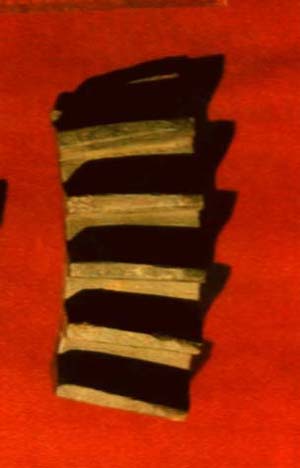

Report on the "DIG" Trout Hollow 1999
Work Began on June 1 1999 with transit survey, setting out grids, and tying the two sites to be investigated at Trout Hollow together. |
|||||||||||||||||||||||||||||||||||||||||||||||||||||||||||||||||||
SITE 1 The Mill Among the items found on the surface was a fragment of a large steel bevel wheel, which helps confirm the location of the mill. Toothed bevel wheels are used with shafting in large power transmission systems with a second similarly shaped gear wheel to transfer power perpendicularly. The fragment found at Trout Hollow is 5cm wide and 13 cm long but radically broken at both ends. The gear cogs are spaced at 1 cm intervals and are 1.3 to 1.5 cm deep. Only one of the bricks was analyzable, as all others were too highly broken up. The brick had been surface collected from the mill area being 10.7 X 6 cm half, red hand moulded with a hand impressed small frog depression one side. Hand moulding of bricks was common in Ontario until the late 19th century. Both the steel bevel and the bricks could be associated with either the Trout's mill or the later short-lived Pleasant Valley Grist Mill. |
|||||||||||||||||||||||||||||||||||||||||||||||||||||||||||||||||||
|
SITE 2 The Cabin The Privy Area The Structure Area |
||||||||||||||||||||||||||||||||||||||||||||||||||||||||||||||||||
 |
ARTIFACTS The two river bank area units produced the largest number of in situ artifacts. It appears to represent a more active activity area or midden. Both areas contained ceramics, bottle and window glass, nails and a clay smoking pipe fragment. These artifacts conform to 19th century origins |
||||||||||||||||||||||||||||||||||||||||||||||||||||||||||||||||||
 |
SUMMARY The two river bank area units produced the largest number of in situ artifacts. The site appears to represent a more active activity area or midden. Both areas contained ceramics, bottle and window glass, nails, and a clay smoking pipe fragment. These artifacts conform to 19th century materials.
The mill location is confirmed by the 1858 map. The cabin location is almost certain, suggested by the 1858 map and it is at least a structure dating to the Trout era. If not the cabin, it may be a stable building although that is unlikely given the range of artifacts recovered from that site. NOTE A detailed summary of the ceramic types, dates and frequency is available from the authors |
||||||||||||||||||||||||||||||||||||||||||||||||||||||||||||||||||
|